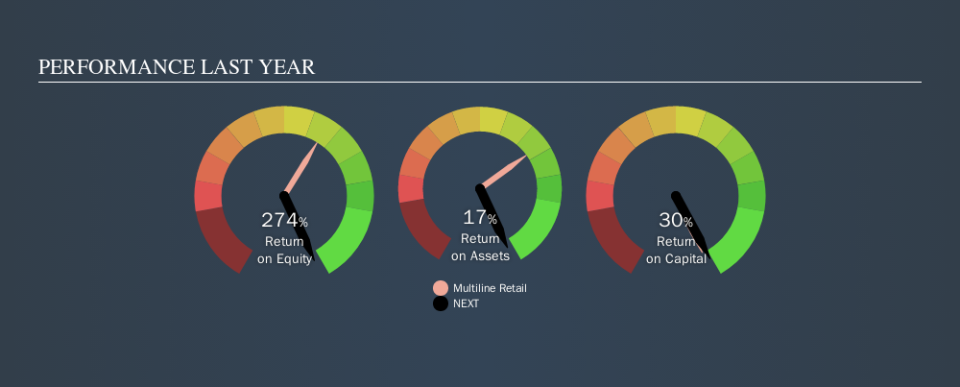NEXT plc (LON:NXT) Is Employing Capital Very Effectively

Today we'll look at NEXT plc (LON:NXT) and reflect on its potential as an investment. Specifically, we're going to calculate its Return On Capital Employed (ROCE), in the hopes of getting some insight into the business.
Firstly, we'll go over how we calculate ROCE. Then we'll compare its ROCE to similar companies. Last but not least, we'll look at what impact its current liabilities have on its ROCE.
Return On Capital Employed (ROCE): What is it?
ROCE measures the amount of pre-tax profits a company can generate from the capital employed in its business. In general, businesses with a higher ROCE are usually better quality. In brief, it is a useful tool, but it is not without drawbacks. Author Edwin Whiting says to be careful when comparing the ROCE of different businesses, since 'No two businesses are exactly alike.
So, How Do We Calculate ROCE?
Analysts use this formula to calculate return on capital employed:
Return on Capital Employed = Earnings Before Interest and Tax (EBIT) ÷ (Total Assets - Current Liabilities)
Or for NEXT:
0.30 = UK£772m ÷ (UK£3.8b - UK£1.3b) (Based on the trailing twelve months to July 2019.)
Therefore, NEXT has an ROCE of 30%.
View our latest analysis for NEXT
Is NEXT's ROCE Good?
One way to assess ROCE is to compare similar companies. In our analysis, NEXT's ROCE is meaningfully higher than the 14% average in the Multiline Retail industry. We consider this a positive sign, because it suggests it uses capital more efficiently than similar companies. Setting aside the comparison to its industry for a moment, NEXT's ROCE in absolute terms currently looks quite high.
NEXT's current ROCE of 30% is lower than 3 years ago, when the company reported a 62% ROCE. So investors might consider if it has had issues recently. The image below shows how NEXT's ROCE compares to its industry, and you can click it to see more detail on its past growth.
When considering this metric, keep in mind that it is backwards looking, and not necessarily predictive. ROCE can be deceptive for cyclical businesses, as returns can look incredible in boom times, and terribly low in downturns. ROCE is only a point-in-time measure. What happens in the future is pretty important for investors, so we have prepared a free report on analyst forecasts for NEXT.
What Are Current Liabilities, And How Do They Affect NEXT's ROCE?
Current liabilities are short term bills and invoices that need to be paid in 12 months or less. Due to the way the ROCE equation works, having large bills due in the near term can make it look as though a company has less capital employed, and thus a higher ROCE than usual. To check the impact of this, we calculate if a company has high current liabilities relative to its total assets.
NEXT has total assets of UK£3.8b and current liabilities of UK£1.3b. As a result, its current liabilities are equal to approximately 33% of its total assets. NEXT has a medium level of current liabilities, boosting its ROCE somewhat.
The Bottom Line On NEXT's ROCE
Even so, it has a great ROCE, and could be an attractive prospect for further research. There might be better investments than NEXT out there, but you will have to work hard to find them . These promising businesses with rapidly growing earnings might be right up your alley.
For those who like to find winning investments this free list of growing companies with recent insider purchasing, could be just the ticket.
We aim to bring you long-term focused research analysis driven by fundamental data. Note that our analysis may not factor in the latest price-sensitive company announcements or qualitative material.
If you spot an error that warrants correction, please contact the editor at editorial-team@simplywallst.com. This article by Simply Wall St is general in nature. It does not constitute a recommendation to buy or sell any stock, and does not take account of your objectives, or your financial situation. Simply Wall St has no position in the stocks mentioned. Thank you for reading.

 Yahoo Finance
Yahoo Finance 
